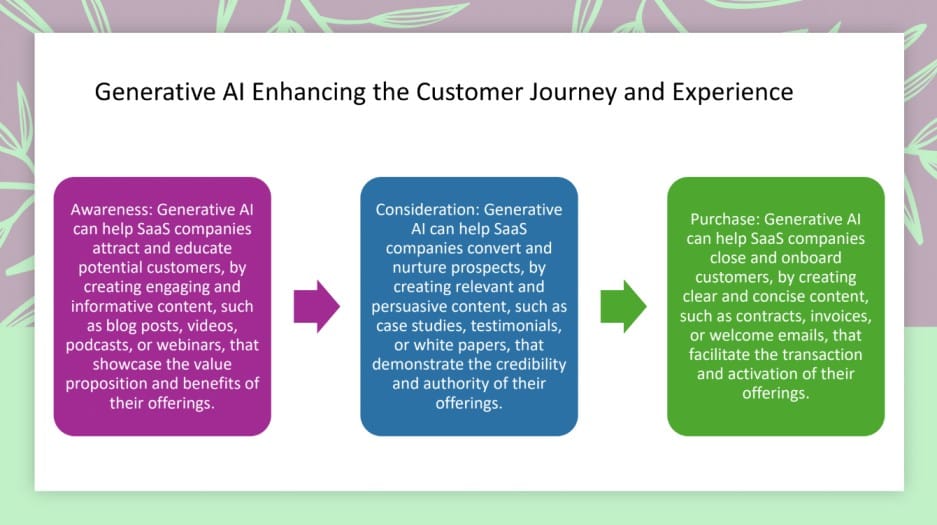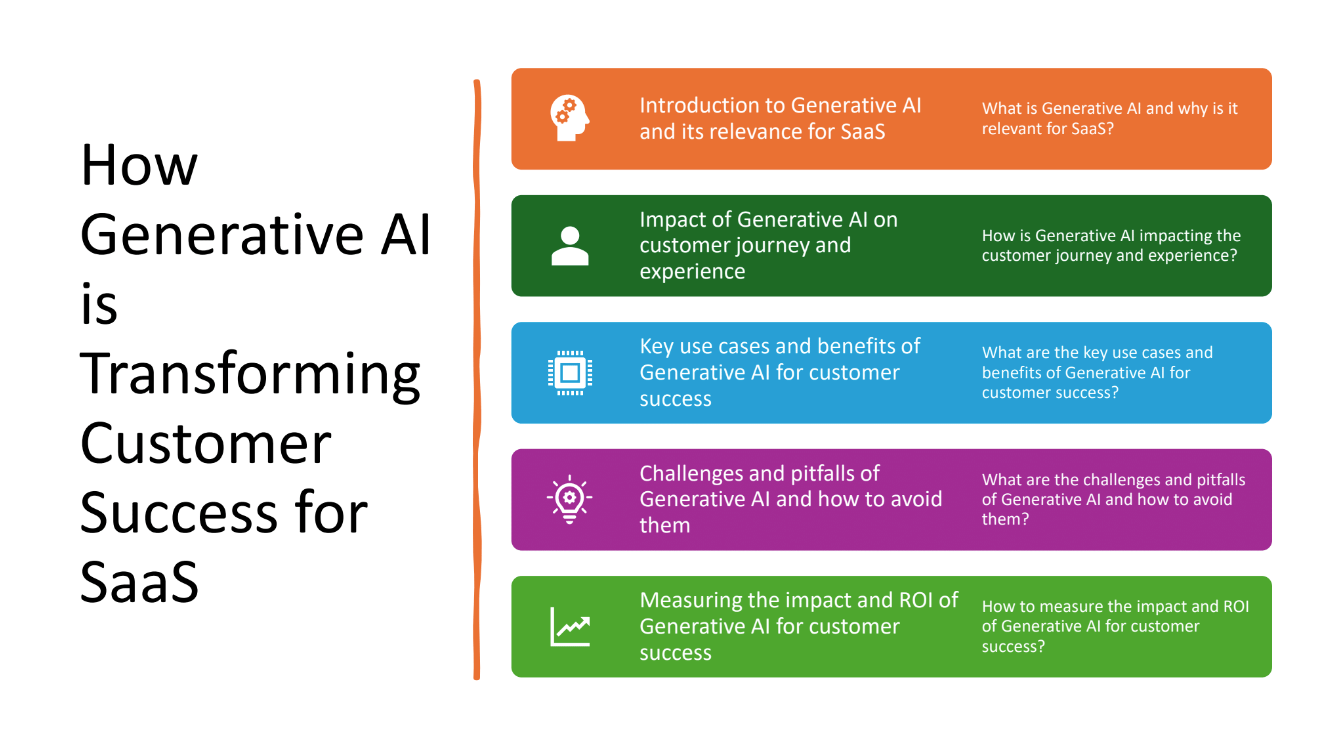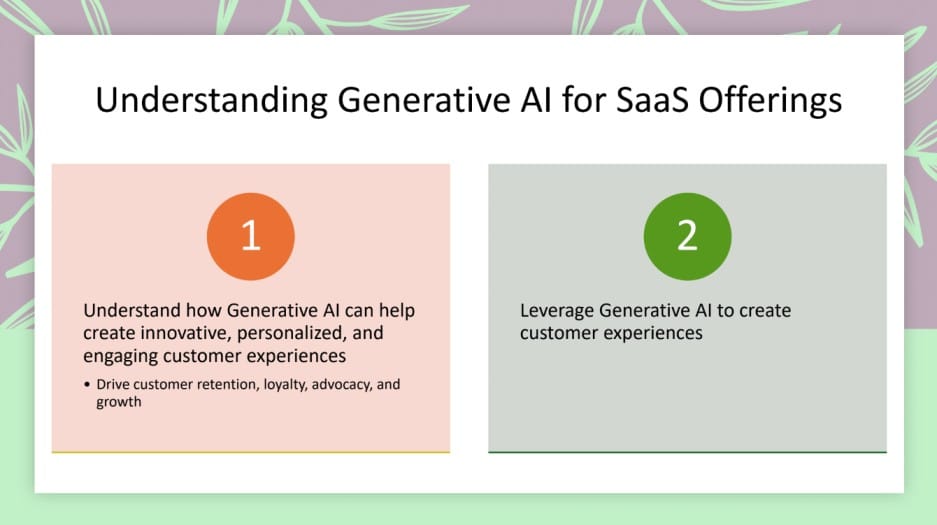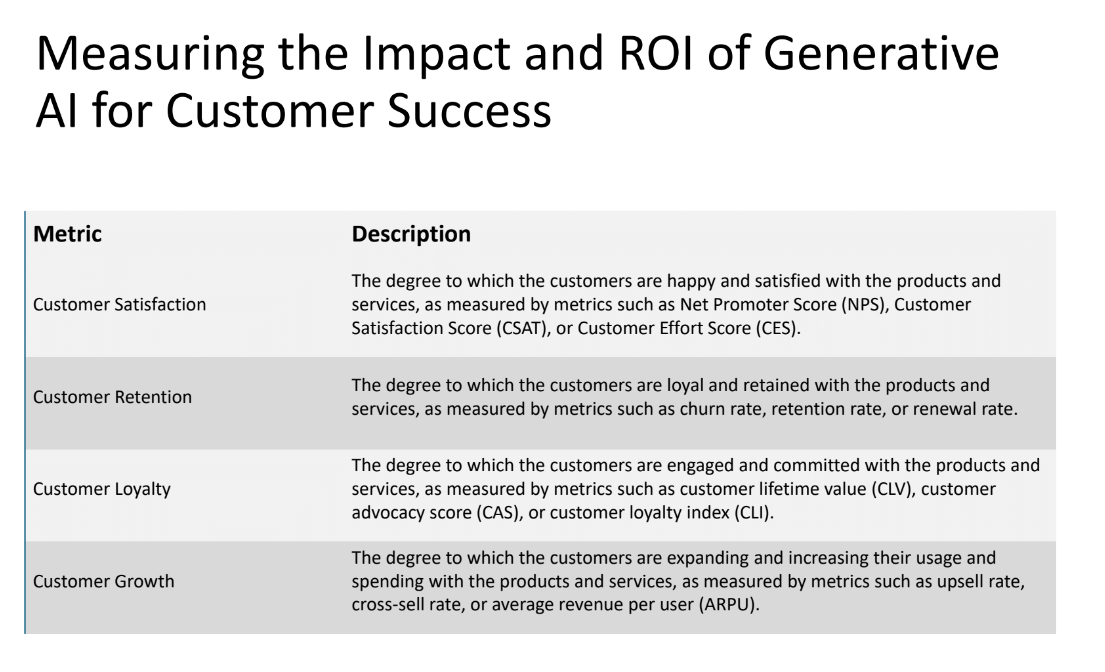This article is based on a presentation given by Ayman at our virtual Customer Success Festival in October 2023.
Catch up on this presentation, and others, using our OnDemand service. For more exclusive content, visit your membership dashboard.
Discovering the incredible capabilities of generative AI in customer success can be an exciting, if not, challenging journey. And when it comes to its application in SaaS businesses, AI thoroughly redefines how we engage, understand, and deliver value to our customers.
The utilization of generative AI stands as a cornerstone for innovation and efficiency in customer relations.
My expertise lies in leveraging cutting-edge solutions to enhance customer experiences and streamline operations in cloud and SaaS environments.
In this article, I'll share insights on how generative AI is transforming what it means for the future of customer success in SaaS firms.
Understanding generative AI
In our journey to explore the transformative power of generative AI in customer success, it's essential to first grasp what generative AI is and its current focus.
Generative AI, a pivotal branch of artificial intelligence, isn't new. Its development has been significantly propelled by advancements in computing technologies, such as faster processors and GPUs.
Generative AI has made it increasingly feasible to create AI-generated content, encompassing text, audio, and video. This is particularly important in the context of customer success. With a wealth of training data, including proprietary content, generative AI enables the creation of highly relevant and valuable content for customers.
In the SaaS industry, generative AI plays a critical role in value creation. It achieves this by automating tasks and processes, particularly those that are repetitive and require consistency. We're in an era where the internet has become integral to customer success strategies.
Generative AI utilizes learning models trained on vast datasets to generate content. For instance, through the application of models based on neurological computing contexts, generative AI can produce varied content like blog posts, FAQ sections, websites, email campaigns, and troubleshooting documents.
One of the most prominent examples of generative AI today is ChatGPT. ChatGPT demonstrates the capability of generative AI to provide rich, FAQ-like experiences. It does this by leveraging the data it was trained on, thereby not only creating new content but also making existing content more versatile and adaptable for different tasks.
When we think about customer success and generative AI, it's about harnessing these capabilities to create more value, reduce costs, and enhance the overall customer experience. This transformation is pivotal in the ever-evolving landscape of SaaS firms, where generative AI is becoming an indispensable tool.
Revolutionizing customer experience with generative AI
As we delve deeper into the role of generative AI in customer success, it's crucial to consider the entire customer experience journey. This journey begins with attracting customers by creating engaging, informative content such as blog posts, videos, podcasts, and webinars.
Traditionally, producing this content demands significant human capital, constrained by training needs and the necessity for repeatability.

Utilizing generative AI in these tasks offers a leap in productivity for Customer Success Managers (CSMs). It allows for the customization of content based on CRM data and tailoring offerings specifically for customers. This approach is particularly effective for SaaS companies aiming to convert prospects into loyal customers by providing them with relevant and value-demonstrating content.
Consider the typical role of CSMs today. They are constantly gathering and analyzing customer data to manage the customer onboarding process, assess product usage, and evaluate churn risks. This data is often derived from surveys, Quarterly Business Reviews (QBRs), and existing CRM data.
By feeding this information into a large language model (LLM), generative AI can be employed to interpret these signals and predict potential churn risks, allowing for preemptive action.
The essence of AI, and by extension generative AI, lies in training and datasets. The quality and extent of the data we have directly influences our ability to create personalized content and collateral, like support documents and customer service materials.
Consider the traditional chatbot experience. It typically involves a back-and-forth interaction to pinpoint the customer's issue. However, generative AI can significantly enhance this process. It can utilize data from various sources, like phone calls or website visits, to generate content that's more relevant and personalized.
This not only streamlines the interaction but also creates a more efficient and satisfactory customer experience. By leveraging generative AI in communications – through emails, chat conversations, or voice – we're able to connect with our customers more effectively, offering them tailored support and a deeper level of engagement.
Implementing generative AI in SaaS
In integrating generative AI into SaaS companies, we focus on its impact on the customer journey and how it can enhance customer success. This involves understanding the specific use cases and recognizing the potential challenges and pitfalls in implementing AI-driven strategies.

A crucial aspect of this journey is the emphasis on measured implementation. It's essential to allocate a budget not just for the implementation of generative AI but also for measuring its effectiveness. This approach ensures that the investment is yielding the desired results and provides an opportunity to adjust strategies as needed.
One of the key challenges in leveraging generative AI is the quality and relevance of the training model. Generative AI is only as effective as the data it's trained on. Therefore, it's vital to be aware of potential pitfalls and how to avoid them. This requires a focused approach to ensure that the AI's use cases and benefits are directly aligned with your SaaS product and the specific domain you operate in.
For successful implementation, the AI must be trained on data points that are pertinent to your domain. This could range from software solutions to services aimed at either consumer or business-to-business models.
Most likely, your SaaS organization already possesses the necessary data, derived from your experiences in the industry. The key is to effectively harness this data to train the generative AI, thereby ensuring it's well-equipped to address your specific customer success needs and challenges.
The journey of integrating generative AI into customer success strategies in SaaS is complex yet immensely rewarding. It requires a strategic approach, focusing on relevance, careful budgeting, and an awareness of potential pitfalls. By doing so, we can effectively transform customer success and create a more engaging, personalized customer journey.
Wielding generative AI for enhanced customer experiences
In the realm of customer success, particularly for SaaS companies, the key to building trust and loyalty lies in creating innovative, personalized, and engaging experiences. This is where generative AI becomes a game changer.

The significance of personalization cannot be overstated – it's the foundation of the trust that customers place in us. When we create content that resonates with our customers, it shows that we understand their needs and preferences.
This can be achieved in two ways: either by intimately knowing the customer and manually creating content or by utilizing generative AI to analyze the wealth of data we already possess about them.
Generative AI enables us to delve into the customer's intent more deeply. By analyzing data like previous buying habits, experiences, support tickets, and troubleshooting documents, generative AI can tailor the customer journey in a way that was previously unattainable.
This approach not only enhances the overall experience with our products and solutions but also strengthens the relationship between the customer and our company.
By employing generative AI, we can significantly augment the customer journey, offering a richer and more satisfying experience with our offerings. This technology enables us to anticipate customer needs, tailor our interactions, and ensure that every touchpoint with our company adds value to their experience.
The use of generative AI in crafting customer experiences is pivotal. It allows us to create a deeper, more meaningful connection with our customers by providing personalized, relevant content and interactions. This, in turn, fosters trust and loyalty, which are essential for long-term customer engagement and success in the SaaS industry.
Innovating with generative AI for product and service development
In the dynamic world of SaaS, generative AI is not just a tool for enhancing customer experience; it's also a catalyst for product and service innovation. Let's delve into how this technology is reshaping the way we develop and improve our offerings.
Imagine a scenario where there's a consistent demand from customers for a new feature in your SaaS product. Traditionally, this feature might end up in a backlog, awaiting prioritization.
However, with generative AI, we can expedite this process enormously. By analyzing customer feedback, telemetry data, and other inputs, generative AI can aid in creating enablement features for faster release cycles. This data-driven approach allows us to address customer needs more promptly and efficiently.
Generative AI can be instrumental in our development processes, particularly in DevOps and Scrum cycles. It enables us to identify common issues or requested features, bringing them to the forefront of our development agenda. This results in quicker iterations, improved performance, and more precisely tailored solutions to meet customer demands.
One of the most significant advantages of generative AI is its ability to create customized features without compromising the uniqueness of each customer's needs. It allows for the generation of repeatable content with subtle customizations, catering to a diverse customer base while maintaining a high level of personalization.
Beyond customer-facing roles, generative AI plays a pivotal role in operational efficiency. It's not only about creating a better product for the customer but also about running our operations more effectively.
From generating contracts and invoices to crafting welcome emails and onboarding journeys, generative AI reduces the need for manual oversight. It understands new customers being onboarded and seamlessly integrates them into the customer success journey, thus driving efficiency and reducing human error, especially in fast-paced work environments.
The innovation brought forth by generative AI extends far beyond customer interaction. It's a comprehensive tool that enhances not only our customer success strategies but also our product development, operational efficiency, and overall business agility.
By leveraging generative AI, we're not just responding to customer needs; we're anticipating them and delivering solutions that are both timely and tailored.

Navigating pitfalls in generative AI implementation
In my experience with generative AI, I've learned the importance of understanding and navigating its pitfalls effectively. This knowledge is crucial for leveraging generative AI in a way that enhances our SaaS products and services without compromising quality or ethics.
The limitations of training data
A fundamental aspect to remember is that a trained model's effectiveness is directly tied to the quality of its training data. Current models like ChatGPT 3.5 and 4.0 are trained on extensive datasets, but these datasets can have limitations.
For instance, if these models are trained on public data, they might inadvertently include inaccuracies, as seen with the example where a model used data from the movie "Interstellar," leading to scientific inaccuracies in its outputs.
Protecting data privacy
It's vital for SaaS companies to train their generative AI models with their own data sets, which don't need to be exposed publicly. This approach not only ensures data privacy but also enables the creation of content that is unique and highly relevant to your company and customers. Remember, the model is a template and should be overlaid on your data to generate the most effective results.
Addressing bias and ethics
Another critical pitfall is bias in generative AI. Bias can arise from limited data or incorrect data interpretation, leading to "hallucination," where the AI makes up information. To mitigate this, we can employ 'grounding' techniques, setting rules that prevent the AI from making assumptions based on incomplete data.
For instance, if certain information is missing in a welcome email, the AI can be programmed to modify its response accordingly.

The importance of ethical considerations
Ethics play a significant role in generative AI. We must be cautious to avoid creating biases against certain groups of people, genders, or ethnicities due to limited data.
This is especially crucial in SaaS, where products may cater to diverse segments and demographics. Ensuring ethical use of data in generative AI is paramount to avoid discrimination and maintain fairness.
Technical considerations and compliance
From a technical perspective, implementing generative AI in SaaS involves several considerations, such as data storage, model selection, and alignment with providers like Google, Microsoft, or OpenAI. Each provider offers different models for various purposes, so choosing the right one for your specific needs is essential.
Risk management in data usage
There are inherent risks in using generative AI, including the potential for malicious or inaccurate data and compliance issues. It's crucial to be aware of regulations governing the use of customer data, especially personally identifiable information. Understanding these risks helps in making informed decisions about training your generative AI models.
While generative AI presents immense opportunities for innovation in SaaS, it also comes with challenges that need careful consideration.
Focusing on the quality of training data, ethical implications, technical requirements, and compliance with regulations will ensure that we use generative AI responsibly and effectively, enhancing our customer success journey while protecting our data and respecting our customers' privacy.

Measuring the ROI of generative AI in SaaS
As we delve deeper into the integration of generative AI into SaaS, it becomes crucial to measure its ROI. The true value of any technological advancement, including generative AI, is revealed through its impact on key performance indicators.

Key metrics to monitor
1. Customer success and satisfaction
Metrics like the net promoter score (NPS), customer satisfaction score (CSAT), and customer effort score (CES) are essential in assessing the impact of generative AI. These scores provide insights into customer loyalty, satisfaction, and the effort required by customers to get their issues resolved.
2. Customer retention and loyalty
Tracking customer retention rates and developing a customer loyalty index are vital. These metrics help in understanding how generative AI contributes to maintaining and enhancing customer relationships over time.
3. Customer growth
Monitoring customer growth is essential to evaluate how generative AI aids in expanding the customer base and increasing revenue.
4. Customer lifetime value
This metric helps in quantifying the overall value a customer brings to the business over the entire duration of their relationship.
%20(1)%20(1).jpg)
Implementing generative AI for CSM efficiency
In my role, I've observed generative AI enhancing CSM productivity in three key ways:
1. Scaling CSM capabilities
Given budget constraints, hiring more CSMs isn't always feasible. Generative AI helps in scaling the productivity of existing CSMs, thereby balancing internal investment.
2. Enhancing customer metrics
If the same number of CSMs can achieve better customer satisfaction, retention, churn mitigation, and growth with the aid of generative AI, it's a clear indicator of its effectiveness.
3. Operational efficiency
From writing content and emails to transcribing meetings, generative AI makes the job of CSMs simpler and more efficient, driving growth and loyalty.
Integrating generative AI in your SaaS strategy
To successfully integrate generative AI into your SaaS organization:
- Focus on content creation: This includes not only public-facing content but also internal documents like onboarding materials, invoices, help documents, and more.
- Be mindful of pitfalls: Pay attention to data quality, ethics, and compliance to mitigate risks and ensure effective use of generative AI.
- Measure impact: Continuously monitor the aforementioned metrics to assess the ROI of implementing generative AI.
Generative AI, in my view, is a transformative technology for SaaS companies. It not only enhances operational efficiency but also fosters a belief among customers that they are understood and valued.
By being responsive and proactive, generative AI can significantly contribute to creating a successful customer journey and experience.

Benchmarking and evaluating generative AI in customer success
I want to emphasize the importance of establishing a benchmark for comparing CSMs with and without generative AI support. This comparison is crucial to understanding the true impact of generative AI on our operations and customer success strategies.
It's vital to assess the efficiencies gained from using generative AI and the investments required to implement it. This evaluation should be done while carefully avoiding pitfalls such as data mismanagement and ethical risks.
Implementing an ROI model is necessary to sift through the hype surrounding generative AI and to clearly understand its return on investment. AI should not be seen as just a 'nice-to-have' feature. It's a tool for creating significant value in customer success roles, helping to do more with less.
Generative AI enables us to quickly adapt to changes in customer buying habits, economic situations, and global political affairs.
Remember, generative AI is a part of the broader AI spectrum, which includes various machine learning models. While generative AI enhances the human touch in customer interactions, other AI forms are equally important in triggering and managing different tasks.
Focus on data, ethics, and risks
To effectively leverage generative AI:
- Data: Ensure the quality and relevance of the data used for training the AI models.
- Ethics: Maintain ethical standards in the use of generative AI, avoiding biases and ensuring fairness.
- Risk management: Be aware of the inherent risks and manage them effectively to avoid any negative impact on your operations or reputation.
Generative AI is a powerful tool for SaaS companies, offering a way to enhance customer experiences and operational efficiencies. However, its success hinges on careful implementation, consistent evaluation, and a strong focus on data integrity, ethical considerations, and risk management.
By embracing these principles, we can harness the full potential of generative AI in transforming customer success.



 Follow us on LinkedIn
Follow us on LinkedIn



